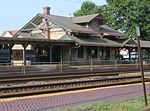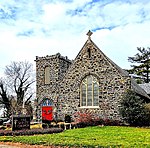Maybrook Mansion
Houses in Montgomery County, PennsylvaniaLower Merion Township, Pennsylvania

Maybrook is a mansion and property located in Wynnewood, Lower Merion Township, Pennsylvania in the Main Line suburban region just outside of Philadelphia. The mansion was built in 1881 as a summer home by liquor baron and real estate developer Henry C. Gibson and his wife, Mary B. Klett and six-year-old daughter Mary Klett "May" Gibson. Gibson named the property for his little daughter and the brook that runs through it.
Excerpt from the Wikipedia article Maybrook Mansion (License: CC BY-SA 3.0, Authors, Images).Maybrook Mansion
Penn Road, Lower Merion Township Wynnewood
Geographical coordinates (GPS) Address External links Nearby Places Show on map
Geographical coordinates (GPS)
| Latitude | Longitude |
|---|---|
| N 40.0058 ° | E -75.2724 ° |
Address
Maybrook
Penn Road
19096 Lower Merion Township, Wynnewood
Pennsylvania, United States
Open on Google Maps






